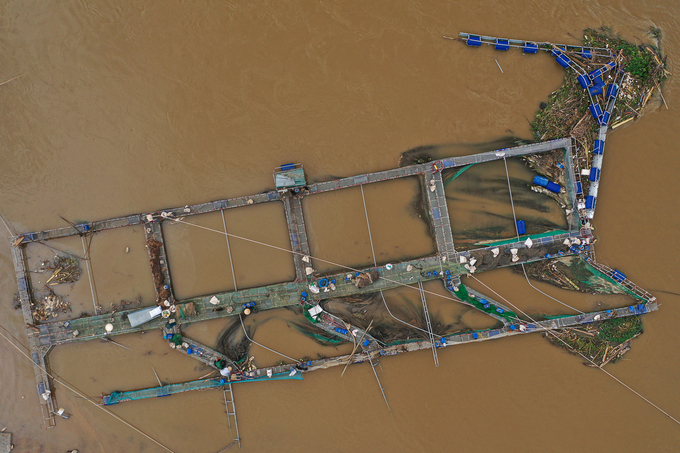November 22, 2025 | 15:32 GMT +7
November 22, 2025 | 15:32 GMT +7
Hotline: 0913.378.918
November 22, 2025 | 15:32 GMT +7
Hotline: 0913.378.918

Wastewater and debris mixing into the environment can increase the risk of disease for aquaculture species. Photo: Tung Dinh.
Storms and floods can cause extensive damage to fish cages as well as create significant pressure for aquaculture farmers, who must restore the environment in their wake. Rainwater and wastewater alter the water quality in ponds and lagoons, leading to a heightened risk of disease in shrimp, fish, and mollusks.
According to Dr. Truong Van Thuong, a lecturer at the College of Economics, Engineering, and Fisheries, the water environment undergoes significant changes after storms and floods. "Environmental shock is one of the most common diseases in aquatic species after heavy rainfall or storms. Accordingly, the salinity in the water decreases after a heavy rain, causing shock to aquaculture species. If the pH level also drops, their health worsens even further," Dr. Thuong explained.
Dr. Truong Van Thuong also noted that several common diseases among aquaculture species during this period include bacterial infections. Fish are often susceptible to a wide range of illnesses, such as ulcers. For instance, the Vibrio bacteria can easily attack the fish when their immunity is low, especially after sustaining injuries from impacts or in overcrowded conditions.
Oxygen deficiency in aquaculture ponds, particularly during the rainy season, often leads to stratification in the water. Separate layers of water that fail to mix can result in oxygen deprivation for fish at lower levels, causing them to float to the surface or die from suffocation.
Master Nguyen Thi Ha, former Deputy Director of the Northern Center for Environmental Monitoring and Aquatic Disease, further explained, "After storms, the immune systems of aquaculture species typically weaken noticeably, leading to a higher risk of disease outbreaks."
In addition to bacterial infections that cause red spot disease and ulcers, fungi and parasites also pose significant challenges for aquaculture species, with young carp and grass carp being the most vulnerable targets. Parasites such as anchor worms, wheel worms, liver flukes, and fish lice can severely damage fish health, leading to mass mortality if famers fail to detect and address them in time.
With the aim of mitigating risks, Dr. Truong Van Thuong recommends several preventive measures to aquaculture farmers. "We need to regularly monitor water quality, with an emphasis on salinity and pH levels," the expert recommended. "Upon detection of changes in the water, it is essential to quickly address the situation by applying lime to stabilize pH and disinfect the pond. The recommended dosage falls between approximately 200 and 300 kilograms per hectare. After treating the water with lime, farmers should wait two to three days before applying probiotics to improve water quality."
Master Nguyen Thi Ha shares Dr. Thuong's perspective and emphasizes the importance of adding immune-boosting substances to feed. Her recommended substances include beta-glucan at a dosage of 5 to 10 grams per 100 kilograms of fish, vitamin C at 2 to 3 grams per 100 kilograms of fish, and garlic powder at 1 to 1.5 liters per ton of feed. Farmers are advised to mix these additives into the feed continuously for five to seven days per cycle.

Upon detecting symptoms of a disease, farmers must focus on immediate treatment. If the fish exhibit signs of illness, such as floating at the surface, swimming lethargically, or a reduced appetite, immediate intervention is necessary.
To treat parasitic diseases such as anchor worms, Master Nguyen Thi Ha recommends that farmers mix crushed chinaberry leaves with water, then evenly spray the solution over the pond. The chinaberry leaves contain alkaloids that, when dissolved, have a strong effect against anchor worms. The bitter properties of chinaberry help prevent the worms from adhering to the fish's fins and skin.
According to Master Nguyen Thi Ha, herbal remedies such as garlic are highly effective in treating bacterial diseases. "Our research indicates that garlic powder can help enhance the fish's resistance," she added.
In severe cases, farmers may utilize antibiotics to treat bacterial infections (note: only permitted antibiotics for aquaculture should be used). Dr. Truong Van Thuong advises, "Antibiotic treatment must be conducted in compliance with the dosage and guidelines provided by the manufacturer to avoid the risk of antibiotic resistance."
On the other hand, farmers should focus on environmental management and providing the appropriate levels of nutrition, along with applying scientific treatment methods, to maintain and develop aquaculture in a sustainable manner. With insights from experts, farmers will gain valuable knowledge to protect their aquatic stocks during challenging times.
Translated by Nguyen Hai Long

(VAN) Official Telegram No. 226/CD-TTg, issued on November 21, 2025, mandates enhanced management and utilization of national reserves to support flood response and relief efforts in the Central Region.

(VAN) The Politburo has demanded a high concentration of efforts on urgent relief tasks, ensuring absolute prevention of hunger, cold, and shortages of clean water or medicine among the population.

(VAN) Water resources during the 2025–2026 dry season in the Mekong River Basin basically meet domestic use and production needs, but localized shortages may still occur due to saltwater intrusion.

(VAN) Vietnam and Japan have committed to deepening cooperation on projects under the Joint Crediting Mechanism (JCM), improving waste management, and advancing the circular economy.

(VAN) Digital transformation is becoming a core driver of proactive, precise, and safer management of dams and reservoirs nationwide.

(VAN) This assistance supports people who temporarily relocate or evacuate, as well as communities affected by major storms from late September to now.

(VAN) Viet Nam will host the 8th ASEAN Heritage Parks Conference, bringing together over 320 delegates and reaffirming its role in regional nature conservation.